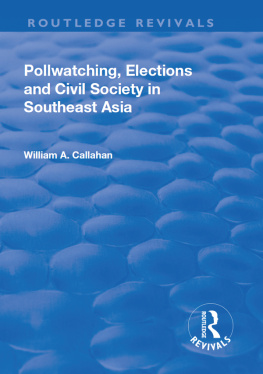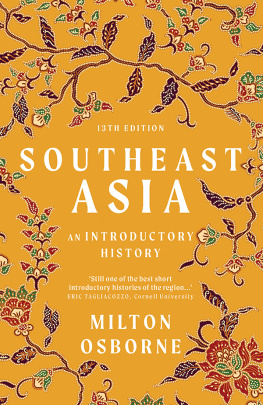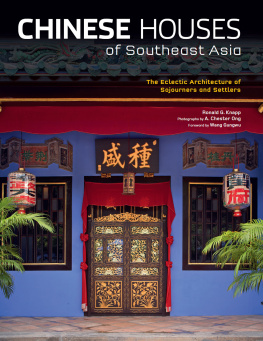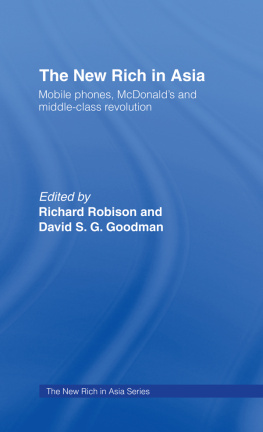ROUTLEDGELIBRARYEDITIONS: MODERN EASTANDSOUTHEASTASIA
Volume1
BEHIND THEMYTH
BEHIND THE MYTH
Business, Money and Power in Southeast Asia
JAMES CLAD
First published in Great Britain in 1989 by the Trade Division of Unwin
Hyman, Limited
This edition first published in 2015
by Routledge
2 Park Square, Milton Park, Abingdon, Oxon, OX14 4RN
and by Routleddge
52 Vanderbilt Avenue, New York, NY 10017
Routledge is an imprint of the Taylor & Francis Group, an informa business
1989 James Clad
All rights reserved. No part of this book may be reprinted or reproduced or utilised in any form or by any electronic, mechanical, or other means, now known or hereafter invented, including photocopying and recording, or in any information storage or retrieval system, without permission in writing from the publishers.
Trademark notice: Product or corporate names may be trademarks or registered trademarks, and are used only for identification and explanation without intent to infringe.
British LibraryCataloguinginPublicationData
A cataloguerecordforthisbookisavailablefromtheBritishLibrary
ISBN: 978-1-138-89258-3(Set)
eISBN: 978-1-315-69792-5(Set)
ISBN: 978-1-138-90120-9(Volume1)
Publishers Note
The publisher has gone to great lengths to ensure the quality of this reprint but points out that some imperfections in the original copies may be apparent.
Disclaimer
The publisher has made every effort to trace copyright holders and would welcome correspondence from those they have been unable to trace.
BEHIND
THE MYTH
BUSINESS, MONEY
AND POWER
IN SOUTHEAST ASIA
JAMES CLAD
First published in Great Britain by the Trade Division of Unwin Hyman Limited, 1989
James Clad, 1989
All right reserved. No part of this publication may be reproduced, stored in a retrieved system, or transmitted in any form or by any means, electronic, mechanical, photocopying, recording or otherwise, without the prior permission of Unqin Hyman Limited.
UNWIN HYAN LIMITED
1517 Broadwick Street
London W1V 1FP
Allen & Unqin New Zealand Pty Ltd with the Port Nicholson Press Compusales Building, 75 Ghuznee Street, Wellington, New Zealand
British Library Cataloguing in Publication Data
Clad, James
Behind the myth: Business, money and power in Southeast Asia.
1. South-east Asia, economic development
I. Title
330.959
ISBN 0-04-302011-9
Typeset in ten in eleven point Plantin
Printed in Great Britain by The University Press, Cambridge
CONTENTS
To the memory of my mother
In the 1980s, the world became aware of the extraordinarily economic success of East Asia Japan, South Korea and Taiwan. Few realise, though, that economic growth in Southeast Asia has been almost as successful. Over the past two decades countries such as Indonesia, the Philippines, Thailand, Malaysia, and Brunei have grown at an unprecedented rate. From 1980 to 1987 their economies increased by 4.8 per cent per annum, a very respectable rate by any standard. So why should one not trumpet the story of Southeast Asian success as well as that of East Asia?
Few are better qualified to do this than James Clad. He has served in the Asian branch of the New Zealand foreign service and understands the diplomatic issues. As a former lawyer specialising in company law, he has a keen sense of the businessmans point of view, and after a year each at Harvard and Oxford on fellowships he has a wide academic knowledge of the area. In his years in Southeast Asia he has developed friendships that give his writing a sense of intimacy. But above all, he writes as a journalist who has covered Southeast Asia for the Far Eastern Economic Review, the leading journal of the region. He is fascinated by the throb of each country and writes tersely, as if trying to cram in every detail a page will hold.
Clad searches persistently for the inside story and, alas, the story he finds is often not an entirely happy one. Behind the glossy exterior and the myth of success lie a host of problems. East Asian countries have undoubtedly achieved extraordinary success in providing high levels of education and standards of living for all their people, and in spawning businesses and an economic bureaucracy which enable their nations to be masters of their own fate. In Southeast Asia, however, the base of success is weak, tattered and fragile; large numbers of people still receive only a low level of education and live in poverty. Businessmen and political leaders, meanwhile, have siphoned off enormous fortunes without playing any constructive role in promoting their countries, and the fortunes are not reinvested. Too many local businessmen have been content to sell off their nations resources their oil, rubber and tin. Perhaps worst of all, they have profiteered while vast tropical forests have been felled, and are now dangerously close to depletion with no plans for their replacement.
The success of Southeast Asia depends on outside finance, outside technology and outside management. Some local leaders have shared in the fruits of the success, but not enough have learned the secrets of that success and how to capture it for their own country, or how to develop their own initiative. Even Singapore, the best educated country in Southeast Asia, with the finest bureaucracy, is very dependent on outside companies for its economic health. The infrastructure projects instigated by foreign loans and technical assistance are often poorly maintained.
Hovering in the background of Clads account of Southeast Asia is the re-emergence of Japan as the dominant power in the region. In recent years, direct Japanese investment there has been more than three times that of the United States. The closest thing to a regional financial institution is the Asian Development Bank, dominated by the Japanese. So far every president of this bank has been nominated by the Japanese and, not surprisingly, a substantial amount of the goods procured by bank loans come from Japanese companies. And yet, for all its managerial skills and information, this bank does not emerge in Dads account as a very happy or successful one. The Japanese have shown only a limited interest in building up strong local economies and in making direct investment they prefer self-owned subsidiaries. Since local governments and business do not have the ability to provide a counterweight, one can imagine future conflicts as Japanese power, galloping along at great speed, encounters the forces of local nationalism.
One wonders why the people of Southeast Asia have not been as ambitious as those in East Asia in making their countries strong. Why have so many Southeast Asian leaders been content merely to siphon off the fruits of their earnings while countless East Asian businessmen and bureaucrats have been willing to live modestly and plough the fruits of their earnings into productive assets? Why have so many Chinese in Taiwan built up their own manufacturing plants while Chinese in Southeast Asia (many of whom were originally from the same province of Fujian as those in Taiwan) are apparently happy to stick with commerce, finance and profits? Why would leaders with tens of millions of dollars not be content with their wealth and not be willing to reinvest additional earnings in their country? Clad is not so pretentious as to give systematic answers to these questions, but a careful reader who ponders the meaning of his stories will be able to reach some very informed conclusions.








